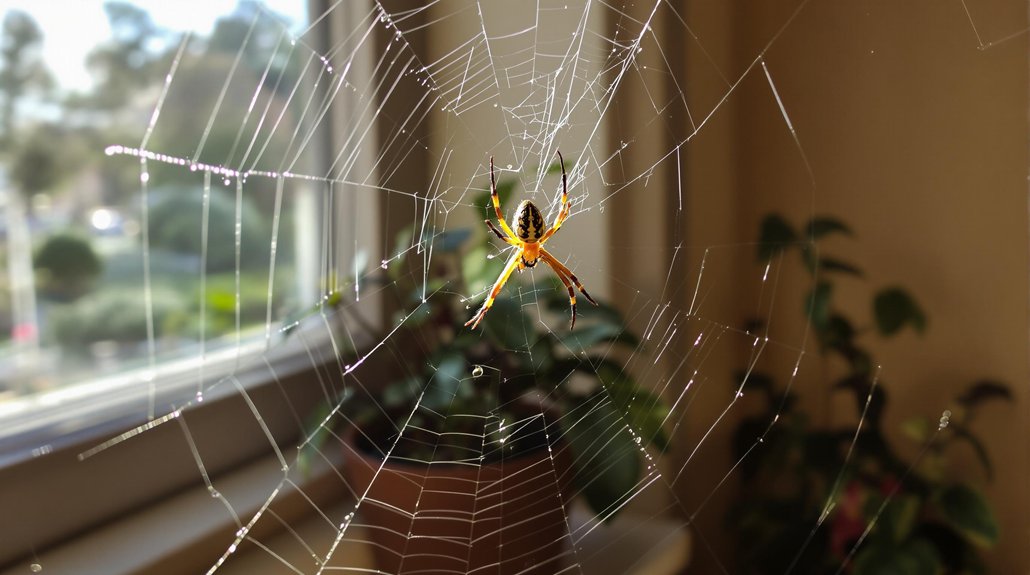Spiders are attracted to homes in Clayton North Carolina mainly due to abundant insect prey and cluttered spaces that provide hiding spots. High humidity and moisture from leaks or damp areas make the environment more inviting. Bright outdoor lights attract insects, which serve as food sources for spiders. Unorganized storage areas and outdoor lighting increase the chances of spider entry. To learn more about prevention, consider exploring additional steps homeowners can take.
Key Article Highlights
- High indoor insect populations, especially near outdoor lights, attract spiders seeking prey.
- Cluttered, undisturbed areas like basements and garages provide hiding spots and shelter.
- Excess humidity, damp areas, and leaks create ideal conditions for spiders and their prey.
- Outdoor lighting, particularly ultraviolet lights, draws insects that serve as spider food.
- Unsealed storage containers and untidy spaces increase spider habitats and access points inside the home.
Presence of Other Insects and Pest Activity

The presence of other insects and active pests often attracts spiders into homes. Spiders feed on insects, so areas with a high pest population increase their likelihood of entering a residence. Effective pest control reduces the number of insects indoors, decreasing the food source for spiders. Using spider traps can help monitor and limit spider activity, especially in areas where pest activity is detected. These traps not only capture spiders but also serve as an early warning system, indicating pest presence nearby. Eliminating or reducing pest populations through targeted pest control measures is essential for long-term spider management. Maintaining a clean, pest-free environment minimizes the chances of spiders being drawn indoors, ultimately reducing their presence and the need for frequent intervention.
Clutter and Hidden Spaces
Clutter and hidden spaces in a home can create ideal hiding spots for spiders. These areas provide shelter and easy access to prey, increasing the likelihood of spider presence. To minimize these risks, homeowners should focus on organizing spaces and reducing clutter.
Decluttering and organizing reduce hiding spots, helping prevent spider infestations.
Key strategies include:
- Clearing out storage areas such as basements and garages
- Regularly cleaning behind furniture and appliances
- Using sealed containers for stored items
Environmental Conditions Favoring Spiders
Certain environmental conditions within a home can make it more attractive to spiders. Spiders seek out habitats that provide shelter, such as corners, cluttered areas, and undisturbed spaces. These environments offer ideal hiding spots and hunting grounds. Seasonal changes also influence spider activity; as temperatures drop or rise, spiders may migrate indoors seeking warmth or shelter. Humidity levels can further impact spider presence, with damp areas like basements, bathrooms, and crawl spaces becoming preferred habitats. Consistent moisture and stable temperatures create favorable conditions for spiders to thrive. By understanding these environmental factors, homeowners can better manage spider populations. Reducing clutter, controlling humidity, and sealing entry points diminish suitable spider habitats, making the residence less attractive to these arachnids.
Light Sources That Attract Prey

Light sources that emit ultraviolet or bright, warm light often draw insects, which serve as prey for spiders. These lights attract a high concentration of insects, increasing spider activity near homes. Excessive outdoor lighting contributes to light pollution, disrupting natural insect behavior and creating ideal hunting grounds for spiders. Spiders tend to gather around areas with frequent insect activity, especially near outdoor lighting fixtures.
Bright outdoor lights attract insects, increasing spider activity near homes.
- Bright outdoor lights attract large numbers of insects, providing abundant food sources.
- Ultraviolet light is particularly effective at drawing insects compared to other wavelengths.
- Reducing outdoor lighting or switching to insect-friendly fixtures can decrease prey availability for spiders.
Proper management of outdoor lighting helps control the insect population, thereby reducing the likelihood of spiders being attracted indoors.
Humidity and Moisture Levels in the Home
High humidity and excess moisture in the home create ideal conditions for spiders to thrive. Humidity sources such as leaking pipes, damp basements, and poorly ventilated areas increase moisture levels, attracting spiders seeking hydration and shelter. Elevated moisture levels support the growth of prey insects like flies and beetles, further drawing spiders into the environment. Maintaining low humidity and controlling moisture sources reduce the likelihood of spider infestations. Proper ventilation, fixing leaks, and using dehumidifiers can effectively manage humidity levels. By keeping moisture levels in check, homeowners make the environment less hospitable for spiders and their prey. Understanding how humidity sources influence indoor moisture is essential for preventing spider attraction and minimizing their presence in the home.





